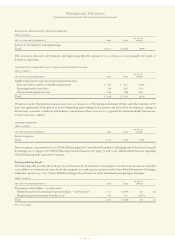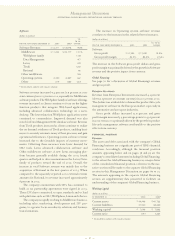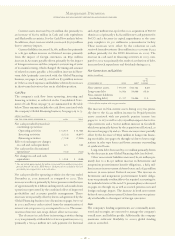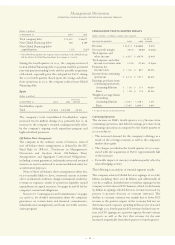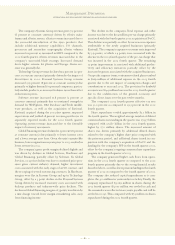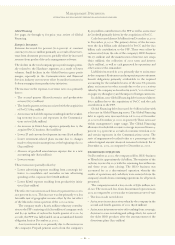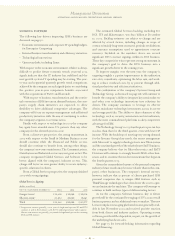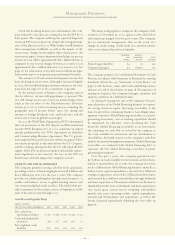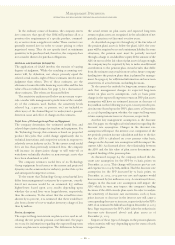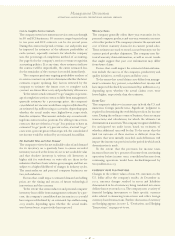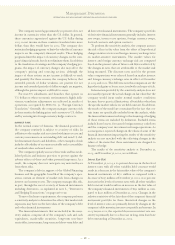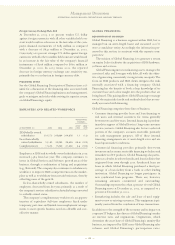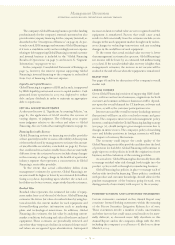IBM 2003 Annual Report Download - page 65
Download and view the complete annual report
Please find page 65 of the 2003 IBM annual report below. You can navigate through the pages in the report by either clicking on the pages listed below, or by using the keyword search tool below to find specific information within the annual report.
looking forward
The following key drivers impacting IBM’s business are
discussed on page 50:
•Economic environment and corporate IT spending budgets
for Enterprise Computing
•Internal business transformation and efficiency initiatives
•Technological innovations
•Open standards, including Linux
With respect to the economic environment, while it is always
difficult to predict future economic trends, year-end 2003
signals indicate that the IT industry has stabilized and the
next growth cycle in IT spending may be starting. The year-
to-year and sequential quarterly growth trend comparisons
achieved by the company are such signals (prior to considering
the positive year-to-year comparison benefits associated
with the acquisitions of PwCC and Rational).
With respect to business transformation and the contin-
ual conversion of IBM into an on demand business, the com-
pany’s supply chain initiatives are expected to allow
flexibility to drive additional competitive advantages. The
company will focus on expense management and additional
productivity initiatives with the aim of continuing to reduce
the company’s expense-to-revenue ratios.
Finally, with respect to technology, in 2003 the company
has again been awarded more U.S. patents than any other
company for the eleventh year in a row.
From a client-set perspective, the strong momentum in
2003 with respect to the Small & Medium Business sector
should continue while the Financial and Public sectors
should also continue to benefit from, among other things,
the company’s new z990 mainframes. The Communications,
Distribution and Industrial sectors may not grow as fast. The
company reorganized Global Services and Software to be
better aligned with the company’s industry sectors. This
change will foster an even greater ability to create industry-
specific solutions for clients.
From a Global Services perspective, the company finished
2003 with strong signings.
Global Services Signings
(dollars in millions)
FOR THE YEAR ENDED DECEMBER 31: 2003 2002 2001
Longer-term*$«34,608 $«33,068 $«32,016
Shorter-term*20,854 20,020 19,261
Total $«55,462 $«53,088 $«51,277
*Longer-term contracts generally 7 to 10 years in length and represent SO and BTO
contracts as well as BCS contracts with the U.S. federal government and its agencies.
Shorter-term contracts are generally 3 to 9 months in length and represent the remaining
BCS and ITS contracts.
The estimated Global Services backlog, including SO,
BCS, ITS and Maintenance, was $120 billion at December
31, 2003. Backlog estimates are subject to change and are
affected by several factors, including changes in scope of
contracts (mainly long-term contracts), periodic revalidations
and currency assumptions used to approximate constant
currency. Included in the numbers above are several
significant BTO contract signings within its BCS business.
These key competitive wins represent strong momentum in
the company’s goal to drive the BTO business into a
significant growth driver in the coming years.
To improve margins over the next year, the company is
targeting roughly a 4-point improvement in the utilization
rate of its consultants, optimizing the labor mix, and work-
ing to reduce overhead costs by 15 percent through addi-
tional productivity and efficiency initiatives.
The combination of the company’s Systems Group and
Technology Group, as discussed on page 118, will continue to
benefit the company’s ability to integrate key semiconductor
and other core technology innovations into solutions for
clients. The company continues to leverage its eServer
zSeries mainframe technology investments across its server
and storage portfolio. The ability to share elements of this
technology, such as security, automation and virtualization,
with the more commoditized platforms is a key competitive
advantage for IBM.
The Technology Group’s 2003 fourth quarter pre-tax loss
was less than that for the third quarter, even with lower IP
income. With the backdrop of meeting very strong demand
for the Systems Group’s key needs, the recent arrangement
with Microsoft to supply technology for its new Xbox system
and the continued growth of the relatively new E&TS business,
the company believes that its Microelectronics and E&TS
Divisions will continue to strongly benefit IBM’s other busi-
nesses and to continue the modest momentum that began in
the fourth quarter 2003.
Given the commoditized nature of the personal computer
industry, future results may be more volatile than in the com-
pany’s other businesses. The company’s internal surveys,
however, indicate that 57 percent of clients purchased IBM
personal computers due to unique IBM features such as
ThinkVantage technologies that often lower the cost to oper-
ate and maintain the machines. The company will attempt to
continue to build on these types of differentiating factors.
As for the company’s Software business, key to future
growth will be the continued leveraging of ISVs as an overall
business partner and an additional route to market. The new
Lotus workplace messaging platform became generally avail-
able in late November 2003 and received positive reaction
from both clients and industry analysts. Operating system
software growth will be dependent, in part, on the growth of
the underlying hardware sales.
See page 73 for forward-looking information regarding
Global Financing.
Management Discussion
INTERNATIONAL BUSINESS MACHINES CORPORATION AND SUBSIDIARY COMPANIES
63



